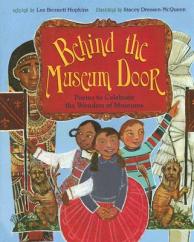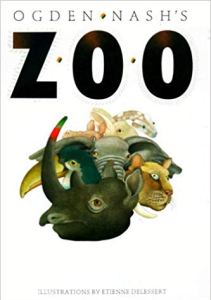Did you know that today is National Go to an Art Museum Day—and more than 30,000 museums around the world are participating by holding special activities and offering discounts? No? Well then, it’s probably too late to call in sick or play hooky. But you can still celebrate vicariously by going to your library, bookstore, or favorite online site to pick up a great book about art museums. Here are a few suggestions:
 From the Mixed-Up Files of Mrs. Basil E. Frankweiler by E.L. Konigsburg
From the Mixed-Up Files of Mrs. Basil E. Frankweiler by E.L. Konigsburg
Okay, you had to know I’d include this classic novel if you’re a fan of this blog. In E.L. Konigsberg’s 1968 Newbery winner, Claudia Kincaid decides to run away with her little brother to the Metropolitan Museum of Art in New York City. After spending their days wandering around the museum and their nights hiding in odd exhibits, the two become involved in solving a museum mystery concerning an angel statue, thought to be carved by Michelangelo himself. After some sleuthing, they track down Mrs. Basil E. Frankweiler, the woman who sold the statue to the museum. Will she help them solve the mystery? You’ll have to read the book to find out.
 Framed by James Ponti
Framed by James Ponti
Florian is twelve years old and has just moved to Washington. He’s learning his way around using TOAST, which stands for the Theory of All Small Things. It’s a technique he invented to solve life’s little mysteries such as: where to sit on the first day of school or which Chinese restaurant has the best egg rolls. But when he attempts to teach the method to his new friend Margaret, they uncover a mystery at the National Gallery of Art that involves the theft of three paintings. Will Florian’s skills help the FBI solve the crime and help him escape from the clutches of a dangerous crime syndicate?
 The Art of the Swap by Kristine Asselin and Jen Malone
The Art of the Swap by Kristine Asselin and Jen Malone
Hannah Jordan lives in a museum…well, sort of. She is the daughter of the caretaker for mansion-turned-museum The Elms in Newport, Rhode Island. Hannah is captivated by stories of The Elms’s original occupants, especially Maggie Dunlap, the tween heiress who was the subject of a painting that went missing during a legendary art heist in 1905. When a mysterious mirror allows Hannah and Maggie to switch places in time, suddenly Hannah is racing to stop the heist from happening, while Maggie gets an introduction to iPhones, soccer, and freedoms like exploring without supervision. Not to mention the best invention of all: sweatpants (so long, corsets!). As the hours tick away toward the art heist, something’s not adding up. Can the girls work together against time—and across it—to set things right? Or will their temporary swap become a permanent trade?
 Moxie and the Art of Rule Breaking by Erin Dionne
Moxie and the Art of Rule Breaking by Erin Dionne
Moxie Fleece knows the rules and follows them—that is, until the day she opens her front door to a mysterious stranger. Suddenly Moxie is involved in Boston’s biggest unsolved mystery: The Isabella Stewart Gardner Museum art heist. Moxie has two weeks to find the art, otherwise she and the people she loves will be in big-time danger. Her tools? Her best friend, Ollie, a geocaching addict who loves to find stuff; her Alzheimer’s suffering grandfather, Grumps, who knows lots more than he lets on; and a geometry proof that she sets up to sort out the clues. It’s a race against the clock through downtown Boston as Moxie and Ollie break every rule she’s ever lived by to find the art and save her family.
 The Metropolitans by Carol Goodman
The Metropolitans by Carol Goodman
The day Japan bombs Pearl Harbor, four thirteen-year-olds converge at the Metropolitan Museum of Art where an eccentric curator is seeking four brave souls to track down the hidden pages of the Kelmsbury Manuscript, an ancient book of Arthurian legends that lies scattered within the museum’s collection, and that holds the key to preventing a second attack on American soil. When Madge, Joe, Kiku, and Walt agree to help, they have no idea that the Kelmsbury is already working its magic on them. They begin to develop extraordinary powers and experience the feelings of King Arthur, Queen Guinevere, Morgan le Fay, and Lancelot: courage, friendship, love…and betrayal. Are they playing out a legend that’s already been lived, over and over, across the ages? Or can the Metropolitans forge their own story?
 The Sixty-Eight Rooms by Marianne Malone
The Sixty-Eight Rooms by Marianne Malone
Almost everybody who has grown up in Chicago knows about the Thorne Rooms. Housed deep inside the Chicago Art Institute, they are a collection of sixty-eight exquisitely crafted miniature rooms. Each room is set in a different historic period, and every detail is perfect. Some might even say, the rooms are magic. But what if on a field trip, you discovered a key that allowed you to shrink so that you could sneak inside and explore the secrets of the rooms? What if you discovered that others had done so before you? And that someone had left something important behind? Eleven-year-olds Jack and Ruthie are about to find out!
 Behind the Museum Door: Poems to Celebrate the Wonders of Museums by Lee Bennett Hopkins, illus. by Stacey Dressen-McQueen
Behind the Museum Door: Poems to Celebrate the Wonders of Museums by Lee Bennett Hopkins, illus. by Stacey Dressen-McQueen
Fourteen poems on the many dazzling collections featured in museums. The art, artifacts, and anthropological treasures found in museum collections are coupled with stunning poetry by acclaimed writers Lee Bennett Hopkins, Jane Yolen, Myra Cohn Livingston, Rebecca Kai Dotlich, and many more. The lively verse captures the wonder and amazement of the exhibition experience, from mummies to medieval relics, and from fine art to fossils.








 How old were you when you first began to write? Some wonderkids began their publishing journey long before others of their age could read, let alone write.
How old were you when you first began to write? Some wonderkids began their publishing journey long before others of their age could read, let alone write.






 Canadian author Gordon Corman was twelve when his track-and-field coach became his English teacher. Given the freedom to write whatever he wanted, Gordon set to work on a novel that eventually became
Canadian author Gordon Corman was twelve when his track-and-field coach became his English teacher. Given the freedom to write whatever he wanted, Gordon set to work on a novel that eventually became